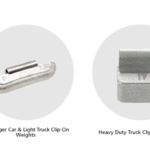“Facts do not cease to exist because they are ignored.”
Most people believe that their tires are balanced if they don’t feel any shaking while driving. But that’s not always true. In reality, wheel balancing weights play a quiet but powerful role in how your vehicle moves, handles, and wears over time. A small misjudgment here can lead to bigger issues — from uneven tire wear to steering problems.
Let’s break down the myths around these tiny components that do more than they’re given credit for.
1. “If My Car Isn’t Shaking, Everything’s Fine”
This is one of the most common ideas drivers have. But lack of vibration doesn’t always mean your wheels are balanced. Sometimes the imbalance is too mild to feel, but strong enough to wear out your tires early. Wheel balancing weights are added specifically to keep things smooth at all speeds, not just when you feel something is off.
2. “All Balancing Methods Are the Same”
Many think any shop using a machine will do the job right. But not all balancing tools are updated. Outdated equipment can miss small errors. A high-quality balance needs the correct wheel balancing weights, modern machinery, and proper placement. Even a few grams off can make your car feel different on the road.
3. “You Only Need to Balance New Tires”
False. New tires do need balancing, yes, but so do older ones from time to time. Over months of driving, tires wear down unevenly. Potholes and curbs can shift weights. Even removing and reinstalling a tire can throw things off. Regular checks are smart, especially after any tire repair or rotation.
4. “Stick-On and Clip-On Weights Are Interchangeable”
Not always. Stick-on wheel balancing weights are mainly used for alloy wheels or where clips won’t work. Clip-on weights are better for steel rims. Using the wrong type can damage your wheels or fall off easily. A skilled technician chooses the right weight based on the wheel type, design, and finish.
5. “Balancing and Alignment Are the Same Thing”
These two are very different services. Balancing is about even weight around the wheel and tire. Alignment is about how your wheels sit and point. Confusing them leads people to fix the wrong issue. Always ask your shop which one your car needs.
6. “Wheel Weights Don’t Matter in the Long Run”
They do. Small shakes from unbalanced tires can become large vibrations. These put stress on your suspension and steering. You may feel it in the steering wheel or seat. Left unchecked, this can damage parts, reduce fuel economy, and cause early tire wear. All from ignoring the need for correct wheel balancing weights.
7. “You Can Do Wheel Balancing at Home”
Technically, no. Balancing tires needs machines that measure spin and weight distribution. These are not tools most people have in their garage. Guesswork can make the problem worse. Even if you place weights by eye, you won’t know if they’re accurate or secure.
8. “All Shops Use Quality Weights”
Unfortunately, no. Some lower-end shops may use cheap or incorrect wheel balancing weights. These can corrode, fall off, or not stay in place. Others may reuse old weights, which is not ideal. Always ask about the materials they use and their balancing process.
9. “A Balanced Tire Stays Balanced Forever”
Not true. Road bumps, tire wear, and even temperature changes can shift weights slightly. That’s why many experts suggest checking balance every 5,000 to 6,000 miles. It’s a simple way to protect your tires and ride quality long term.
10. “Alignment Fixes All Driving Issues”
If your car pulls to one side or shakes, most assume it’s an alignment issue. But wheel balancing weights might be the real fix. If the tires are spinning unevenly, you’ll feel it through the steering, even if your alignment is perfect. Balancing should be checked before and after alignment work to be sure.
Closing Thoughts:
Good driving isn’t just about fast engines or strong brakes. It’s also about balance, real balance. Misunderstanding the role of wheel balancing weights can lead to small issues turning into expensive repairs. Regular checks help your tires last longer and your ride feel steady.
At the same time, don’t forget the other key part, the wheel alignment system. This system ensures your wheels point straight and meet the road properly. Without proper alignment, even balanced tires won’t perform their best. Both balancing and alignment go hand in hand for a safer, smoother ride.
- Common Misconceptions About Wheel Balancing Weights
- If your car pulls to one side or shakes, most assume it’s an alignment issue. But wheel balancing weights might be the real fix.
- wheel balancing weights, wheel alignment system
Related posts:
 Corporate Limo Service in Lakewood, TX | Jacks Limo for Business Travel
Corporate Limo Service in Lakewood, TX | Jacks Limo for Business Travel
 Reliable HVAC Repair in Rifle, CO | Smoky Hill Roofing Experts
Reliable HVAC Repair in Rifle, CO | Smoky Hill Roofing Experts
 How to Choose the Best Battery Service for Your Vehicle Near
How to Choose the Best Battery Service for Your Vehicle Near
 When it comes to promoting dating offers, should native ads be used?
When it comes to promoting dating offers, should native ads be used?
 Best Mobile Car Mechanics in Guildford NSW – Fast, Reliable & Convenient
Best Mobile Car Mechanics in Guildford NSW – Fast, Reliable & Convenient
 Seu guia para instalar capas de assento TTR 230 como um profissional
Seu guia para instalar capas de assento TTR 230 como um profissional
 The Ultimate Guide to Buying Used Tractors for Sale Louisiana Offers
The Ultimate Guide to Buying Used Tractors for Sale Louisiana Offers
 Importance of Learning Farz Uloom Course in Pakistan Farz Uloom Course
Importance of Learning Farz Uloom Course in Pakistan Farz Uloom Course








